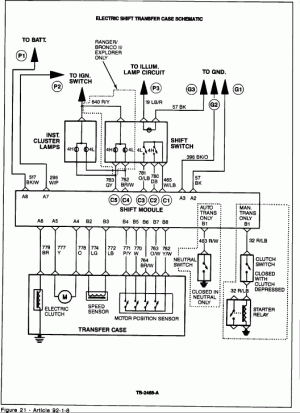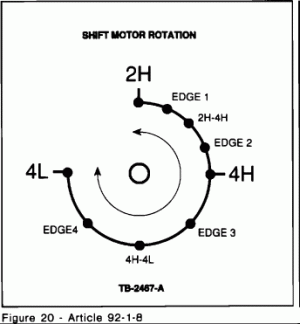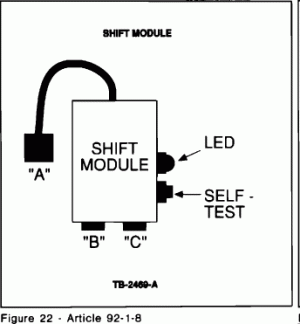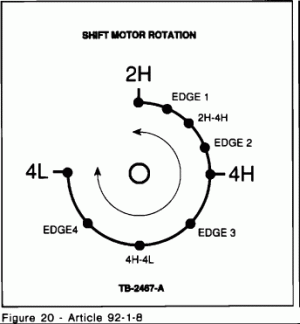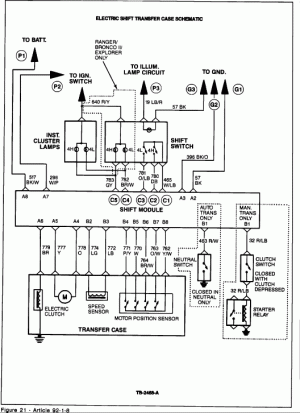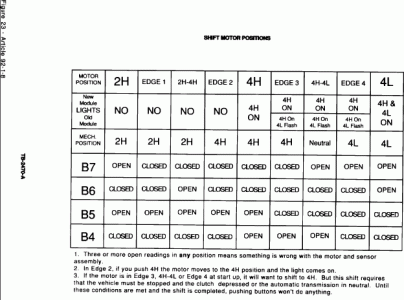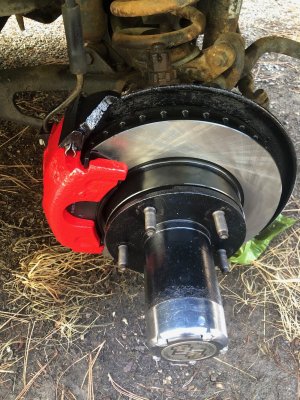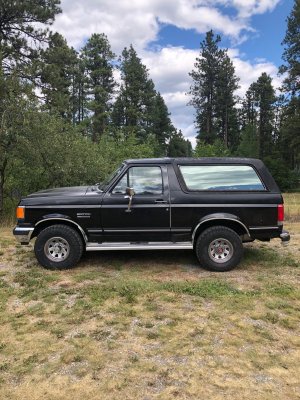Yo Friend,
As Tiha advised and try slapping the shift motor with a rubber (preferred) hammer. Shift motors seem to be #1 fault.
See Nothing happens (dead system). ' see
Diagnosis of the Electric Shift 4 X 4
The Ford "Touch Drive" shift-on-the-fly system is currently available on Ranger, Bronco, F-Series and Explorer. Following are the six common concerns most often expressed by customers:
| 1. | Nothing happens (dead system). |
| 2. | No range shift. |
| 3. | Attempt to shift into 4H from 2H or 4L results in the module clicking and chattering and the system stops in 2H. |
| 4. | At start up, the vehicle shifts on its own. |
| 5. | Indicator lights don't register the correct information. |
| 6. | Shifting on the fly isn't smooth and may require stopping in order to complete the shift. |
All these conditions can be best understood by taking a close look at a schematic of the electrical system (Figure 21). We will be referring to this schematic throughout this article.
Power In
Power is supplied to the system at 3 points (P1, P2 and P3 in schematic):
P1. This is a direct connection to the battery. This power drives the electric shift control motor and provides current to the instrument cluster lamps. This circuit goes to ground G1.
P2. The electronic shift control module is tied into the ignition circuit. This circuit provides power to the computer and goes to ground G2.
P3. Nighttime illumination is provided by a connection to the vehicle's nighttime illumination circuit, which goes to ground G3.
The electronic shift control module directs power depending on the position of the control switches. You will notice that inputs and outputs to and from the shift module are labeled "A", "B" or "C." "A" circuits are power circuits, "B" circuits are data circuits from sensors and "C" circuits are activating switch and related lamp circuits.
We have already explained the power in circuits "A." The "B" circuits supply data from three sources: The speed sensor, the motor position sensor and either a neutral switch (for automatic transmissions) or a clutch switch (for manual transmissions).
The speed sensor is important because the vehicle must be stopped for a shift into or out of 4L. The shift module won't make the shift if the vehicle is moving. The shift module also won't make a shift to 4L or back unless an automatic transmission is in neutral or the clutch is depressed on a manual transmission.
The motor position sensor indicates the position of the shift motor shaft. This shaft turns through approximately 270 degrees and should stop at three indexed points, 2H, 4H and 4L (Figure 20). The shift control module needs to know where the shaft is before making a new shift. When this sensor isn't functioning properly or the motor stops slightly off location, the shift control module may become "confused."
The "C" circuits involve the switches on the vehicle's control panel. When everything is working properly, activating a switch will result in either a shift from 2H to 4H or back, or a shift from 4H to 4L or back. The default operating mode is 2H. This means that in the absence of other instructions, the shift control module will assume that the vehicle should be in 2H. If there is a failure in the system during shifts or engine start up, it will default the vehicle to 2H and permit continued operation.
DIAGNOSIS
With this background, let's diagnose our six problem areas.
Nothing Happens (Dead System)
The obvious first step in diagnosing a dead system is to check the power sources, fuses and grounds. If these check out, you should run the shift control module self-test. Figure 22 shows the module with pigtail "A," "B" and "C" attachments. The self-test button and self-test LED are located on the side of the shift control module.
Disconnect the "B" and "C" connectors, turn on the ignition and allow 4 seconds for the module to power up. Then push the self-test button. If the LED doesn't illuminate, the module is dead and must be replaced. If the LED comes on and stays on for 30 seconds, there is an error condition and the module will have to be replaced. If the module is OK the LED will flash 4 times.
This test, however, is not 100 percent accurate. During the test, the vehicle isn't operating, so the shift control module isn't receiving data and initiating shifts. If the unit passes the self-test, it's probably a good module. Go on to check for other probable causes, but don't rule out the module entirely. If your search doesn't turn up any other cause, it may be the module after all. You may have to try replacing the module even though it passed the self-test.
Check Sensors
A logical next step is to check the three sensors with the ignition on. The transmission sensors (manual or automatic) should be closed with the clutch in, or the automatic shift in neutral. The speed sensor should show 225-275 ohms with the vehicle stopped. Check at the module connection.
Check both the motor position sensors and the wiring harness at B4, B5, B6 and B7 and the input from B8 (see Figure 21). Make sure the harness is OK first, then check the contacts against the chart in Figure 23. Each valid combination of open and closed switches indicates a different position of the motor. For example, at the 4H position, B7 is closed, B6 is closed, B5 is open and B4 is open. Besides the three main positions (2H, 4H and 4L), intermediate positions are also shown - three between 2H and 4H and three between 4H and 4L (see Figure 20 and the chart in Figure 23). Combinations other than those shown in Figure 23 indicate a defective motor sensor assembly.
Check Transfer Case Motor
To check if the transfer case motor is actually functioning (because it may be hard to hear it in a noisy shop) attach a voltmeter to A4 and A5. Have someone activate a shift and look for a brief (one second) increase in voltage and listen for the relay to click on, then off.
If there is power present, then the control module is trying to run the motor. At this point, unbolt the motor and have someone activate a shift again. If the motor doesn't actually turn, it is malfunctioning and must be replaced.
If there is no power to the motor, check both the power circuits again and the sensors. If there is incorrect sensor data, the module won't power the motor.
Check Shift Switches
If the problem isn't in the sensors or the motor, you should next check the control panel switches. Make this check with the ignition on. Disconnect the "B" and "C" connections to the sensors, so that their data won't confuse the diagnosis. Now check power at the C1 connection at the module. There should be 5 volts coming from the shift control module to the 4H and 4L switches. Check C1, C2, and C3 for short to ground.
You can check the switches themselves by disconnecting C1 and checking continuity across C1 to C2 and C1 to C3. If current passes when the switch buttons are pushed, the switches are OK.
Finally, check for a short between C2 and C3 by bridging between them and activating the 4H and 4L buttons. There are situations where wiring harnesses get crushed in such a way that two wires are crushed together and short, even though there is no short to ground.
Check Lamps
To check the lamps, turn the ignition on and ground C4 and C5. The lamps should light.
END
●

